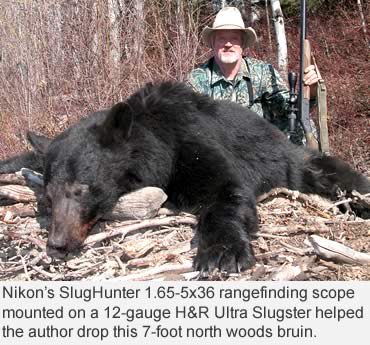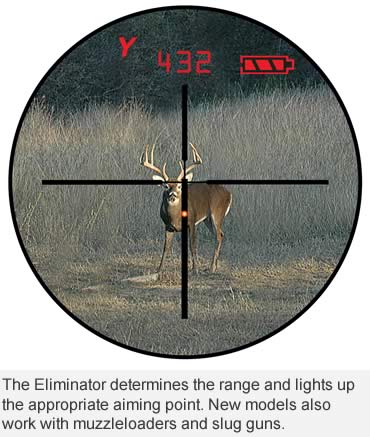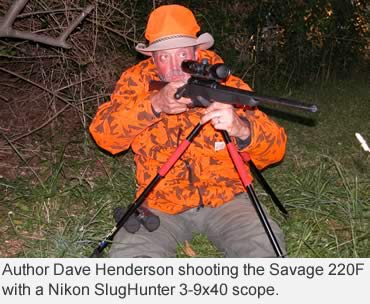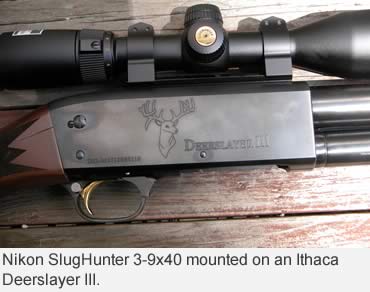The author travels to Wyoming to push the envelope of slug gun performance.
Photo: An unlikely pairing: the Burris Eliminator Laserscope mounted on a Savage 220F shotgun for hunting open-country game.
For a slug shooter, these are uncharted waters.
Most folks don’t bring a shotgun into the potentially long-range scenario of pronghorn hunting on the Western plains. It’s akin to bringing a knife to a gunfight.
But atop my Savage 220F is a Burris Eliminator Laserscope, and I know the capabilities of the slug gun and load. I guess you could say that we’ve come to Wyoming to push the envelope.
It had been a mad dash from the Gillette airport to the ranch, near the town of Moorcroft. We hurriedly sighted-in to hunt the following day, the season opener for pronghorn hunting in the Cowboy State.
Burris’ Pat Beckett gave me a crash course on the Laserscope. We zeroed it at 50 yards. At 100 yards, groups were impressive. Things get interesting at 150 yards and even more so at 180.
With dusk upon us and daylight fading fast, I settled into the bench again. The scope’s display read 256 yards. I slid off the safety and gently pressured the AccuTrigger. After a discernible delay, the 9-inch gong clanged and started swinging, confirmation that the slug struck home.
 Yeah, 256 yards with a 20-gauge shotgun slug.
Yeah, 256 yards with a 20-gauge shotgun slug.
To prove it was no fluke, we repeated the performance 12 times straight. I have no doubt that if we’d had enough slugs and more daylight, the whole thing could have been repeated at 300 yards and maybe farther.
Granted, the 20-gauge, 260-grain Remington AccuTip sabot slug pretty much runs out of energy at 256 yards. But the point is that the Burris Eliminator 4-12x42mm Laserscope put the slug dead-on, time after time well beyond the load’s effective range.
In 30 years of shooting slugs regularly, I’ve never experienced anything like it. I left the range supremely confident of the slug/gun/scope’s potential out to at least 200 yards.
The Eliminator proved extremely popular when it was introduced for rifle use in 2010. The model I was using, configured for shotguns and muzzleloaders, was introduced three months later at the 2011 SHOT Show.
Last summer, I’d provided Burris engineers with the 200-yard drop of the 20-gauge Remington AccuTip slug when zeroed at 50 yards, plus the barrel length and twist rate of my Savage 220F slug gun. To the scope, they input elevation, mean temperature and other variables.
On a makeshift range, we zeroed the scope at 50 yards, punched in a programming number for the load, and then got to shooting more distant targets.
 Operating the Laserscope is far simpler than one would think, given its sophistication. You simply put the crosshairs on a target and push an activation button on the right side of the scope. It gives a readout of yardage out to 500 yards on a deer-sized animal and illuminates a one-third- MOA aiming dot to give you the exact hold.
Operating the Laserscope is far simpler than one would think, given its sophistication. You simply put the crosshairs on a target and push an activation button on the right side of the scope. It gives a readout of yardage out to 500 yards on a deer-sized animal and illuminates a one-third- MOA aiming dot to give you the exact hold.
And I mean exact. If the shotgun, load and shooter are in sync, the gong rings.
At 26 ounces, the scope/mount adds substantially to the weight of a hunting rig. However, the scope mounts low and offers acceptable eye relief (3.5 inches) for slug shooting.
As previously mentioned, my scope was programmed for a long shot on the prairie. Imagine my disappointment when a pronghorn buck presented himself at 55 yards!
Hunting partner Aaron Carter was more fortunate, dropping a pronghorn buck at 421 yards with an Eliminator Laserscope on an E.R. Shaw rifle in .284 Win.
A month later, I mounted the Eliminator scope on a single-shot, bull-barreled, 20-gauge H&R Slugster. It regularly shoots new Lightfield 3-inch Hybred Mag-20 sabot slugs into sub-inch clusters at 100 yards. The combination proved just as accurate as the Burris/Savage/Remington combo out to 200-plus yards.
Long-range success on a subsequent Texas whitetail hunt was derailed by high winds, and I settled for a 100-yard kill. Thus, my only hunting experience with the Eliminator scope has been at close range. I can’t wait for the 2011 hunting season.
 Optics for Shotguns
Optics for Shotguns
Until the 1980s, very few people ever put a scope on a slug gun. Slugs and barrels simply weren’t accurate enough to warrant an aiming system more sophisticated than a front bead. Scoping a shotgun was viewed as a waste, like putting racing tires on a dump truck.
Rifled slug barrels and sabot slugs changed the shotgunning world in the 1990s, and optics became a requisite to utilizing the full potential of the new loads.
Granted, you could mount a riflescope on a shotgun, but cheap ones don’t hold up to slug gun recoil. Also, a shotgun scope requires more eye relief and a shorter parallax setting than a centerfire scope.
Early shotgun scopes were fixed low-power versions. I had a 2x Simmons that replaced a 4x Leupold. As slugs’ effective range increased, more powerful scopes were needed. Enter the 1-5x, 2-7x and 3-9x variables.
Nikon introduced the first rangefinding scopes for slug guns in 2006 with its SlugHunter line of 3-9x40 models. These featured the BDC 200 reticle with “ballistic aiming circles” for 100- and 150-yard shooting, and the top of a post for 200-yard targets.
Nikon later added the BDC 200 to its more economical 2-7x36 Pro Staff line.
The SlugHunter scopes offer an industry-best, constant 5 inches of eye relief.
 Leupold and Bushnell recently added sophisticated shotgun scopes with compensating reticle configurations of their own. Leupold’s models include the VX1 series in 1-4x20, 2-7x33 and 3-9x40. There’s also the SA.B.R (SAbot Ballistic Reticle) in the Ultimate Slam line.
Leupold and Bushnell recently added sophisticated shotgun scopes with compensating reticle configurations of their own. Leupold’s models include the VX1 series in 1-4x20, 2-7x33 and 3-9x40. There’s also the SA.B.R (SAbot Ballistic Reticle) in the Ultimate Slam line.
Featuring aiming dots from 50 to 300 yards, the SA.B.R. reticle is for both 12- and 20-gauge slug shotguns as well as two- and three-pellet muzzleloader charges.
The 2-7x36 Leupold Ultimate Slam shotgun scope offers 4.2 inches of eye relief at 2x. At 10.5 ounces, it is the lightest of the rangefinding shotgun scopes. The 3-9x40 Ultimate Slam weighs 12 ounces.
Bushnell offers its Trophy XLT 2-7x36 shotgun scope with the DOA (Dead On Accurate) 200 reticle. At 14.3 ounces, it is the heaviest of the rangefinding reticle scopes, but features 5 inches of eye relief.
When doing shotgunning seminars, I advise hunters to pay at least as much for their optics as they do for their slug gun. Invariably, they look at me like a calf stares at a new gate. But think about it, folks. Your slug-shooting outfit is only as good as its aiming device.
Read Recent GunHunter Articles:
• Barrel Fluting: What Does It Do? Fluting makes a barrel distinctive, but there are other benefits, too.
• Make Your Deer Rifle Work Overtime: Turn your big-game rifle into a jack of all trades with light and heavy loads.
This article was first printed in the September 2011 edition of Buckmasters GunHunter Magazine. Subscribe today to have GunHunter delivered to your home.